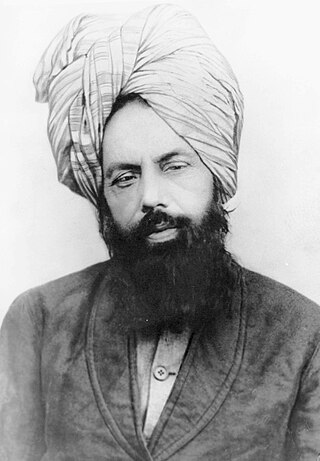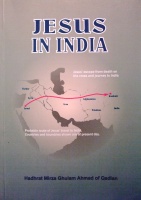
Ashkenazi Jews, also known as Ashkenazic Jews or Ashkenazim, constitute a Jewish diaspora population that emerged in the Holy Roman Empire around the end of the first millennium CE. They traditionally spoke Yiddish and largely migrated towards northern and eastern Europe during the late Middle Ages due to persecution. Hebrew was primarily used as a literary and sacred language until its 20th-century revival as a common language in Israel.

The Jewish diaspora or exile is the biblical dispersion of Israelites or Jews out of their ancient ancestral homeland and their subsequent settlement in other parts of the globe.

MirzāGhulām Aḥmad was an Indian religious leader and the founder of the Ahmadiyya movement in Islam. He claimed to have been divinely appointed as the promised Messiah and Mahdī—which is the metaphorical second-coming of Jesus (mathīl-iʿIsā), in fulfillment of the Islamic prophecies regarding the end times, as well as the Mujaddid of the 14th Islamic century.

African Jewish communities include:

Ahmadiyya Islam considers Jesus (ʿĪsā) as a mortal man, entirely human, and a prophet of God born to the Virgin Mary (Maryam). Jesus is understood to have survived the crucifixion based on the account of the canonical Gospels, the Qurʾān, ḥadīth literature, and revelations to Mīrzā G̲h̲ulām Aḥmad. Having delivered his message to the Israelites in Judea, Jesus is understood to have emigrated eastward to escape persecution from Judea and to have further spread his message to the Lost Tribes of Israel. In Ahmadiyya Islam, Jesus is thought to have died a natural death in India. Jesus lived to old age and later died in Srinagar, Kashmir, and his tomb is presently located at the Roza Bal shrine.
Jewish ethnic divisions refer to many distinctive communities within the world's ethnically Jewish population. Although considered a self-identifying ethnicity, there are distinct ethnic subdivisions among Jews, most of which are primarily the result of geographic branching from an originating Israelite population, mixing with local communities, and subsequent independent evolutions.
Historically, there have been multiple claims and theories conceived that concern the origin of the Pashtun people, who are classified as an Iranic ethnic group native to Central and South Asia.

The Bnei Menashe is a community of Indian Jews from various Tibeto-Burmese ethnic groups from the border of India and Burma who claim descent from one of the Lost Tribes of Israel; some of them have adopted Judaism. The community has around 10,000 members.

The Twelve Tribes of Israel are, according to Hebrew scriptures, the descendants of the biblical patriarch Jacob, who collectively form the Israelite nation. The tribes were through his twelve sons through his wives, Leah and Rachel, and his concubines, Bilhah and Zilpah. In modern scholarship, there is skepticism as to whether there ever were twelve Israelite tribes, with the use of the number 12 thought more likely to signify a symbolic tradition as part of a national founding myth, although some scholars disagree with this view.

The Thirteenth Tribe is a 1976 book by Arthur Koestler advocating the Khazar hypothesis of Ashkenazi ancestry, the thesis that Ashkenazi Jews are not descended from the historical Israelites of antiquity, but from Khazars, a Turkic people. Koestler hypothesized that the Khazars migrated westwards into Eastern Europe in the 12th and 13th centuries when the Khazar Empire was collapsing.
Several groups claim descent from the ancient Israelites. The issue has been especially relevant since the establishment of the State of Israel and an individual or a group's request to immigrate to Israel under its Law of Return. In that context, claims of affiliation with the Israelites give rise to questions of "who is a Jew?" Some of these claims have been recognized, while other claims are still under review, and yet others have been rejected.

The Roza Bal, Rouza Bal, or Rozabal is a shrine located in the Khanyar quarter in downtown area of Srinagar in Kashmir, India. The word roza means tomb, the word bal mean place. Locals believe a sage is buried here, Yuz Asaf, alongside another Muslim holy man, Mir Sayyid Naseeruddin.

The Ten Lost Tribes were the ten of the Twelve Tribes of Israel that were said to have been exiled from the Kingdom of Israel after its conquest by the Neo-Assyrian Empire c. 722 BCE. These are the tribes of Reuben, Simeon, Dan, Naphtali, Gad, Asher, Issachar, Zebulun, Manasseh, and Ephraim; all but Judah and Benjamin. However, since the tribe of Simeon lived well within the territory of Judah, it is not clear why this tribe was never included in this list. Also, the tribes of Asher and Reuben were never mentioned as participating in anything after the conquest, living in either Phoenician (Asher) or Moabite (Reuben) controlled territory. By the middle 9th century BCE the territory of Gad was also (re)taken by the Moabites, so the Assyrians could at most have removed the other six tribes. Thus, the "10 tribes" appears to be a misnomer, meaning all of the Israelites that were living outside the Kingdom of Judah. The Jewish historian Josephus wrote that "there are but two tribes in Asia and Europe subject to the Romans, while the ten tribes are beyond Euphrates till now, and are an immense multitude, and not to be estimated by numbers".

The history of the Jews in Zimbabwe reaches back over one century. Present-day Zimbabwe was formerly known as Southern Rhodesia and later as Rhodesia.

Jesus in India is a treatise written by Mirza Ghulam Ahmad, the founder of the Ahmadiyya Movement in 1889. The treatise, which was then published as a book, puts forward the view that Jesus survived crucifixion, left Judea and migrated eastward in order to continue his mission to the 'Lost Tribes of Israel', traveling through Persia and Afghanistan and eventually dying a natural and honourable death in Kashmir at an old age. The book also makes references to several lost Jewish tribes. Ghulam Ahmad applied textual analysis of both the Gospels and Islamic sources – the Quran and hadith – and also drew upon medical and historical material, including what he claimed were ancient Buddhist records, to argue his case. Some modern scholars such as Norbert Klatt (1988) have rejected Ghulam Ahmad's use of these latter sources as misreadings of material unrelated to Jesus.

Jews or Jewish people are an ethnoreligious group and nation who originate from the ancient Hebrews and Israelites, and whose traditional religion is Judaism. Jewish ethnicity, religion, and community are highly interrelated, as Judaism is an ethnic religion, although not all ethnic Jews practice it. Despite this, religious Jews regard individuals who have formally converted to Judaism as part of the community.
Genetic studies on Jews are part of the population genetics discipline and are used to analyze the chronology of Jewish migration accompanied by research in other fields, such as history, linguistics, archaeology, and paleontology. These studies investigate the origins of various Jewish ethnic divisions. In particular, they examine whether there is a common genetic heritage among them. The medical genetics of Jews are studied for population-specific diseases.
The Japanese-Jewish common ancestry theory is a fringe theory that appeared in the 17th century as a hypothesis which claimed the Japanese people were the main part of the Ten Lost Tribes of Israel. A later version portrayed them as descendants of a tribe of Central Asian Jewish converts to Nestorian Christianity. Some versions of the theory applied to the whole population, but others only claimed that a specific group within the Japanese people had descended from Jews.
The Khazar hypothesis of Ashkenazi ancestry, often called the Khazar myth by its critics, is a largely abandoned historical hypothesis that postulated that Ashkenazi Jews were primarily, or to a large extent, descended from Khazars, a multi-ethnic conglomerate of mostly Turkic peoples who formed a semi-nomadic khanate in and around the northern and central Caucasus and the Pontic–Caspian steppe. The hypothesis also postulated that after collapse of the Khazar empire, the Khazars fled to Eastern Europe and made up a large part of the Jews there. The hypothesis draws on medieval sources such as the Khazar Correspondence, according to which at some point in the 8th–9th centuries, a small number of Khazars were said by Judah Halevi and Abraham ibn Daud to have converted to Rabbinic Judaism. The scope of the conversion within the Khazar Khanate remains uncertain, but the evidence used to tie the subsequent Ashkenazi communities to the Khazars is meager and subject to conflicting interpretations.
Jewish Indian theory is the erroneous idea that some or all of the lost tribes of Israel had travelled to the Americas and that all or some of the Indigenous peoples of the Americas are of Israelite descent or were influenced by still-lost Jewish populations. The theory was popular in the late seventeenth century, and had a lasting legacy through its influence on Mormon belief.












